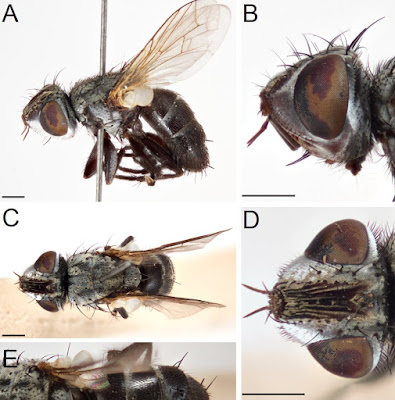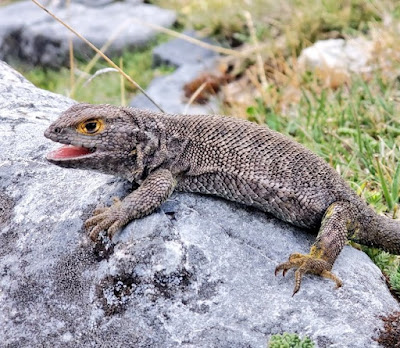[Most Recent Entries] [Calendar View]
Monday, June 29th, 2020
| Time | Event | ||
| 8:13a | [Herpetology • 2020] An Enigma No More: An Integrated Taxonomic Revision of Aenigmetopia Malloch (Diptera: Sarcophagidae: Miltogramminae) reveals Novel Phylogenetic Placement and Four New Species
Abstract Aenigmetopia Malloch is the only endemic genus of miltogrammine flesh flies (Diptera : Sarcophagidae) in Australia and, until now it has been known from a single species, A. fergusoni Malloch. This study constitutes the first comprehensive taxonomic revision of Aenigmetopia. Four new species, Aenigmetopia amissa, sp. nov., A. corona, sp. nov., A. kryptos, sp. nov. and A. pagoni, sp. nov., are described through the integration of molecular and morphological data and characters for genus- and species-level diagnoses are given. Aenigmetopia is included in a molecular phylogenetic analysis for the first time and the genus emerges as the sister taxon to Metopia Meigen, in agreement with morphological evidence. Keywords: DNA barcoding, flesh flies, phylogenetics. Nikolas P. Johnston, James F. Wallman, Krzysztof Szpila and Thomas Pape. 2020. An Enigma No More: An Integrated Taxonomic Revision of Aenigmetopia Malloch reveals Novel Phylogenetic Placement and Four New Species (Diptera : Sarcophagidae : Miltogrammina | ||
| 9:00a | [Herpetology • 2020] Liolaemus qalaywa • An Endemic New Species of Andean Lizard of the Genus Liolaemus(Iguania: Liolaemidae) from southern Peru and Its Phylogenetic Position
Abstract Integrative evidence of several external morphological characters and molecular phylogenetic analyses of mitochondrial DNA (12S, cyt-b) are used to place a new species of Andean lizard of the genus Liolaemus (Iguania: Liolaemidae) in the Liolaemus montanus group and as sister group of the clade formed by L. signifer. The new species is characterized by a unique combination of morphometric characteristics, scalation, and color pattern. The L. montanus group now contains seventeen species in southern Peru, distributed along the eastern and western slopes of the Andes. Keywords: Andes, Apurimac, Eulaemus, Puna, reptile, systematics, taxonomy Liolaemus qalaywa sp. nov. Diagnosis. We assign L. qalaywa sp. nov. to the L. montanus group because it presents a blade-like process on the tibia, associated with the hypertrophy of the tibial muscle tibialis anterior (Abdala et al. 2019b; Etheridge 1995) and based on molecular phylogeny (Fig. 1). The species of the L. montanus group differ from those of the L. boulengeri group by the complete absence of patches of enlarged scales in the posterior part of the thigh (Abdala 2007). Compared to the species of the L. montanus group, L. qalaywa sp. nov. is a robust lizard differing by its larger size (max SVL = 96.06 mm) from L. andinus, L. audituvelatus, L. balagueri, L. cazianiae, L. chiribaya, L. duellmani, L. eleodori, L. erguetae, L. erroneus, L. etheridgei, L. evaristoi, L. fabiani, L. famatinae, L. fttkaui, L. foxi, L. gracielae, ..... Etymology. The specifc epithet Qalaywa, refers to the Quechua word for the Liolaemus lizards from the high Peruvian Andes. Juan C. Chaparro, Aarón J. Quiroz, Luis Mamani, Roberto C. Gutiérrez, Peter Condori, Ignacio De la Riva, Gabriela Herrera-Juárez, José Cerdeña, Luis P. Arapa and Cristian S. Abdala. 2020. An Endemic New Species of Andean Lizard of the Genus Liolaemus from southern Peru (Iguania: Liolaemidae) and Its Phylogenetic Position. Amphibian & Reptile Conservation. 14(2); 47–63. Resumen.— Utilizamos evidencia integradora de varios caracteres morfológicos externos y análisis flogenéticos moleculares de ADN mitocondrial (12S, cyt-b) que ubican una nueva especie del género Liolaemus (Iguania: Liolaemidae) en el grupo de Liolaemus montanus y como grupo hermano del clado formado por L. signifer. La nueva especie se caracteriza por una combinación única de patrón morfométrico, escamación y color. El grupo montanus del género Liolaemus en Perú contiene diecisiete especies, distribuidas a lo largo de la vertiente oriental y occidental de los Andes en el sur del país. Palabras clave. Andes, Apurímac, Eulaemus, Puna, reptiles, sistemática, taxonomía |
| << Previous Day |
2020/06/29 [Calendar] |
Next Day >> |


